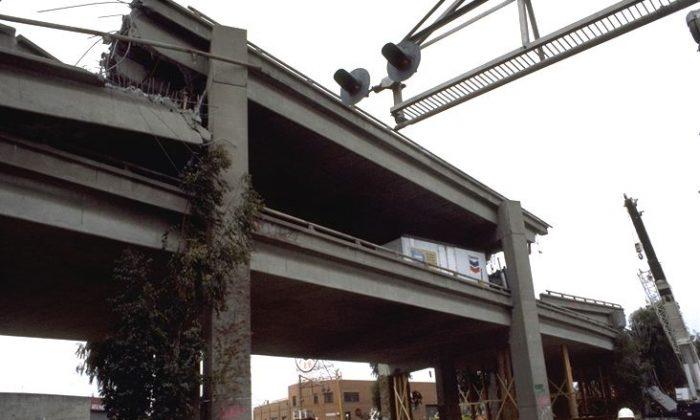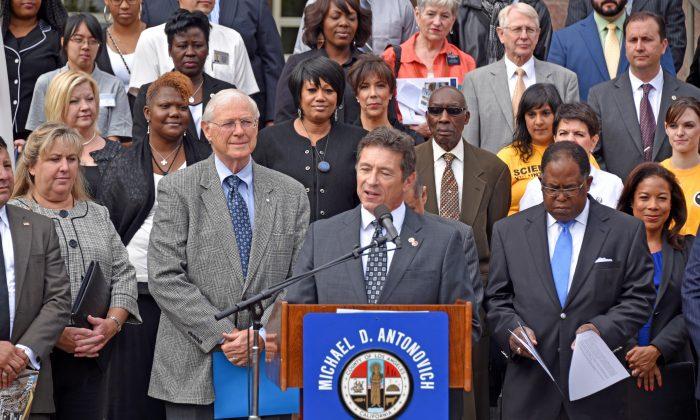Los Angeles—$80 million in seed money was approved for the California Earthquake Early Warning Alert System by California’s legislature and subsequently signed by California Governor Jerry Brown.
On March 13, the experimental California Earthquake Early Warning Alert System signaled an earthquake had taken place. About 30 seconds later, the actual quake could be felt. The 4.7 magnitude quake in Riverside, Calif., was a first test for the developing California earthquake warning system.
There are four major quake zones on earth. The most active is the southern Europe fault zone, which extends into India; the second-most active is the Pacific’s “Ring of Fire,” which includes the entire U.S. Pacific coast.
For California, the greatest population concentrations of the San Francisco Bay Area and the Greater Los Angeles Area also have the greatest risk of earthquake damage, according to studies done by the United States Geological Survey (USGS). In 2010 these areas were home to 27,734,000 Californians—over 8 percent of the nation’s population.
“We live in earthquake country. When it comes to earthquakes in California, it is not a matter of if, but when. A fully developed earthquake early warning system will provide Californians critical seconds to take cover, assist loved ones, or pull over safely to the side of the road. It could allow time to stop a train and power down critical infrastructure. Most importantly, it will save lives,” said Senator Alex Padilla.
In June 2001, the Calistoga Fire Department installed an early P-wave warning system that would activate the fire station siren for a 5.0 or greater earthquake. It was reported that the city followed the lead of fire stations in Albany and Palm Springs, according to the San Francisco Chronicle.
Advance Notice Saves Lives
The USGS, European Union, Japan, Russia, China, and other countries have been working on technologies to provide early earthquake warning systems.
Japan’s sensors allowed the alert warning system to sense a quake about 80 seconds before it arrived. Japan is the most noteworthy because this system saved thousands of lives on March 11, 2011.
Within seconds, after public warnings were communicated via cell phones, computerized signs, radio, TV, etc. , students, workers, shoppers, and others took cover, stopped performing surgery in hospitals, moved away from autos on car racks, exited elevators, and pulled over off of roads.
“A fully developed earthquake early warning alert system would provide Californians critical seconds to take cover, assist loved ones, or pull over safely to the side of the road. It could allow time to stop a train and power down other critical infrastructure,” said Senator Alex Padilla.
Financing
The USGS provided annual funding of $400,000 for the initial phase of the California earthquake warning alert project. In 2011, the Gordon and Betty Moore Foundation provided $6,000,000.
The legislation requires the Office of Emergency Services, in collaboration with the California Seismic Safety Commission, California Institute of Technology, the California Geological Survey, the University of California Berkeley, the United States Geological Survey, and others, to develop a comprehensive statewide earthquake early warning alert system in California. The Office of Emergency Services would have until Jan. 1, 2016, to identify funding for the system. The initial cost estimate to build a statewide system is $80 million.
The current demonstration earthquake system is called the California Integrated Seismic Network (CISN). A fully developed system as required in Senate Bill 135 (Padilla) would process data from an array of sensors throughout the state, detect the strength and the progression of an earthquake, alert the public within seconds, and provide up to 60 seconds advanced warning before potentially damaging ground shaking is felt.
Governor Brown signed the bill into law on Sept. 25. This will fund an upgrade of thousands of sensors in California for the warning system.
“This bill will apply California’s best science and technology to detect seismic activity and alert people in advance of destructive shaking,” Padilla said. “An earthquake early warning system would also speed the response of critical public safety personnel by quickly identifying areas hardest hit by a quake,” Padilla added.
These systems work off of preliminary information that may or may not be indicative of an actual earthquake.
Japan, despite vigorous study and experience, had earthquake prediction rates as high as 82 percent and as low as 28 percent. One problem for these systems is dealing with aftershocks, though Japan has improved its computer programs to obtain a 56 percent rate in Japan’s high aftershock activity environment. By 2015 they expect an 85 percent prediction rate. This research will assist other warning systems in the future.
The California early warning system is one of 15 partners in the Advanced National Seismic System developed by the USGS.





Friends Read Free